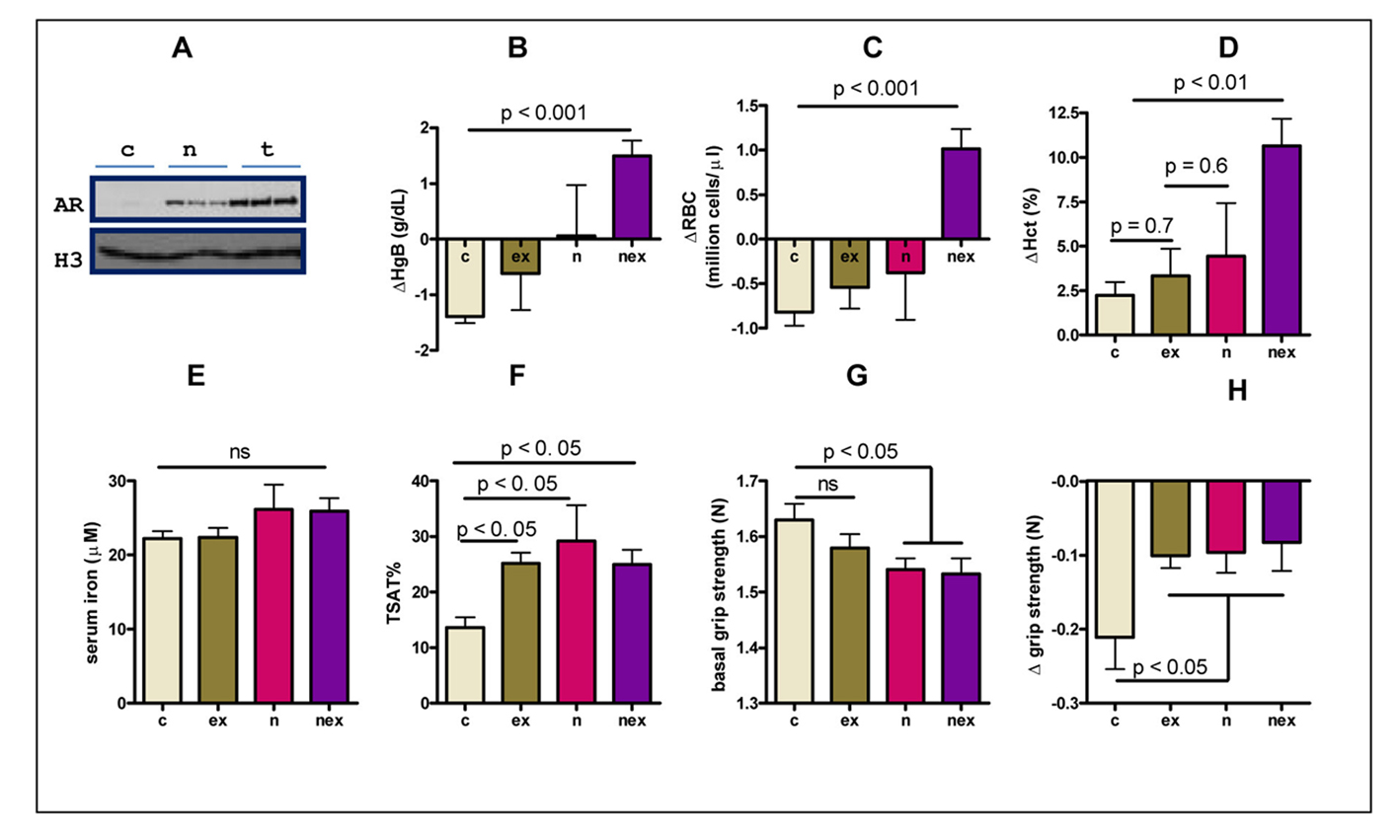| Journal of Hematology, ISSN 1927-1212 print, 1927-1220 online, Open Access |
| Article copyright, the authors; Journal compilation copyright, J Hematol and Elmer Press Inc |
| Journal website http://www.thejh.org |
Letter to the Editor
Volume 3, Number 1, March 2014, pages 22-24
A Combination of Fast-Clearance Nandrolone Plus Low-intensity Aerobic Exercise Improves RBC Indices in Anemic Aging Mice
Michelle Lia, Shalener Bhasina, Eric Bachmanb, Liming Penga, Wen Guoa, c
aResearch Program in Men’s Health, Brigham and Women’s Hospital, Boston, USA
bDepartment of Medicine, Boston University School of Medicine, Boston, USA
cCorresponding author: Wen Guo, Research Program in Men’s Health, Brigham and Women’s Hospital, Boston, USA
Manuscript accepted for publication October 11, 2013
Short title: Improving RBC Indices in Anemic Mice
doi: https://doi.org/10.14740/jh106w
| To the Editor | ▴Top |
Anemia is a common health disorder in the aging population. Conventional therapy to treat anemia with recombinant erythropoietin (rhEpo) has limitations for elderly patients in part because endogenous Epo increases with age even before, and rises further after, anemia becomes apparent [1]. Androgen therapy, the mainstay for anemia treatments before the advent of rhEpo, thus deserves a reevaluation. Low testosterone is not only a marker, but also can be a cause, of anemia in the elderly [2-4]. Androgen-induced erythropoiesis is a long-standing clinical observation recently recapitulated in rodent models. A main disadvantage of androgen therapy is the concern for cardiovascular risk [5]. Noticeably, most clinical and animal studies use esterified androgen to prolong the drug half-life, sustaining tissue exposure to supraphysiological androgen stimulation. This may contribute to cardiac hypertrophy, at least in animal models [6]. We thus tested the effect of intermittent injection of a fast-clearance androgen (unesterified nandrolone) on RBC indices in older mice which developed anemia as a consequence of aging. We also tested whether adding a routine low-intensity aerobic exercise may enhance the effect of this intervention.
The study was conducted on male C57BL/6 mice of 26 - 28 months, corresponding to the 50-40% strain survival window. Twenty-four anemic mice (hematocrit 29-37%) were evenly divided into four groups as control (c), nandrolone (n), exercise (ex) and exercise plus nandrolone (nex). Nandrolone or vehicle (sesame oil) was injected twice per week (100 mg/kg, 100 ul, sc). Body composition, grip-strength and blood were measured before and after the experiment. Animals were trained twice per week as described [6]. Serum nandrolone concentration was measured three days after injection using MASS and estimated to be 250 - 1,000 ng/dl within hours post injection but drop to 3 - 5 ng/dL after 48 h. The steady-state concentration was substantially lower than serum testosterone propionate injected at half the dose [6]. To confirm that the nandrolone was functional, we performed Western analysis for splenic nuclear androgen receptor (AR). In the absence of androgenic ligands, AR is targeted to degradation without nuclear accumulation. As shown in Figure 1A, nuclear AR was undetected in control animals. At 24 h post injection, nandrolone increased nuclear AR but to a lesser extent compared to that induced by testosterone propionate, suggesting that nandrolone is sufficient to activate AR without sustaining high androgen concentrations in circulation. Treatment with nandrolone for two months did not change skeletal and cardiac muscle mass (not shown), compared to 30% historic increase of each after treatment with testosterone propionate following otherwise identical experimental protocols [6].
 Click for large image | Figure 1. Effect of nandrolone and low-intensity exercise on RBC indices, serum iron indices and grip strength. (A) Western analysis for splenic nuclear androgen receptor (AR) with histone3 (H3) as loading control; changes in (B) hemoglobin (C) RBC counts (D) hematocrits*; (E) serum iron, (F) serum transferrin saturation, (G) baseline grip strength, (H) changes in grip strength after two months of intervention. Results are means ± SE, between group comparison by t test. *The increase of Hct in parallel with a decrease in HgB may be explained by an age-related across board rise of MCV which changed from 43.35 ± 2.7 to 51.27 ± 2.2 (fl, means ± SD). The actual number of Hct are c: 35.33 ± 0.59 // 37.57 ± 1.37; ex: 34.24 ± 3.76 // 37.59 ± 4.10; n: 35.16 ± 4.48 // 39.80 ± 3.35; 30.65 ± 3.62 // 41.30 ± 3.95; with // denotes data obtained before and after the interventions. |
Changes in RBC indices for each animal were obtained by subtracting the baseline data from the final measurements. A numerical increase in hemoglobin (HgB) was induced by exercise and more by nandrolone; but each did not reach statistical significance. A combination of exercise and nandrolone, however, induced a significant increase in HgB (Fig. 1B). Similar effect was observed for RBC and hematocrit (Fig. 1C, D). Serum iron was not different among the four groups (Fig. 1E) but transferrin saturation (TSAT) was similarly increased by each intervention (Fig. 1F). TSAT is a measure of transferrin-bound iron, the major source of hemoglobin iron. Finally, we assessed the effect of each intervention on grip-strength for functional assessment. As shown in Figure 1G, grip-strength at baseline was somewhat higher in the control group. Two months later, all animals showed age-related loss in grip-strength, but this loss was attenuated by about 50% in animals that went through exercise or nandrolone interventions, alone or in combination (Fig. 1H).
Together, our results demonstrate that administration of fast-clearance nandrolone to older mice was able to moderately activate AR without sustaining tissue exposure to high concentrations of androgen, minimizing the risk for androgen-induced cardiac hypertrophy. Nandrolone increased serum TSAT and numerically raised RBC indices. Studies using a larger sample size are warranted. Routine low-intensity exercise was also able to increase serum TSAT and produce a small numeric increase in RBC indices. Most important, a combination of nandrolone and low-intensity exercise caused a robust increase in RBC indices, reversing anemia in these animals. Although mechanism remains to be determined, we suggest that the increase of oxygen demand during exercise may contribute. At the functional level, each intervention was able to delay the age-related loss of grip-strength, as would be expected.
Due to their weak anabolic effect, unesterified androgens are rarely used for in vivo studies. Our results suggest that one may take advantage of this “weakness” and turn it into strength for treating anemia while minimizing risk for cardiac hypertrophy. Further investigations are needed to investigate the mechanism of each and combined intervention(s), and to explore potential clinical applications.
| References | ▴Top |
- Ershler WB, Sheng S, McKelvey J, Artz AS, Denduluri N, Tecson J, Taub DD, et al. Serum erythropoietin and aging: a longitudinal analysis. J Am Geriatr Soc. 2005;53(8):1360-1365.
doi pubmed - Ferrucci L, Maggio M, Bandinelli S, Basaria S, Lauretani F, Ble A, Valenti G, et al. Low testosterone levels and the risk of anemia in older men and women. Arch Intern Med. 2006;166(13):1380-1388.
doi pubmed - Fonseca R, Rajkumar SV, White WL, Tefferi A, Hoagland HC. Anemia after orchiectomy. Am J Hematol. 1998;59(3):230-233.
doi - Mohile SG, Mustian K, Bylow K, Hall W, Dale W. Management of complications of androgen deprivation therapy in the older man. Crit Rev Oncol Hematol. 2009;70(3):235-255.
doi pubmed - Spitzer M, Huang G, Basaria S, Travison TG, Bhasin S. Risks and benefits of testosterone therapy in older men. Nat Rev Endocrinol. 2013;9(7):414-424.
doi pubmed - Guo W, Wong S, Li M, Liang W, Liesa M, Serra C, Jasuja R, et al. Testosterone plus low-intensity physical training in late life improves functional performance, skeletal muscle mitochondrial biogenesis, and mitochondrial quality control in male mice. PLoS One. 2012;7(12):e51180.
doi pubmed
This is an open-access article distributed under the terms of the Creative Commons Attribution License, which permits unrestricted use, distribution, and reproduction in any medium, provided the original work is properly cited.
Journal of Hematology is published by Elmer Press Inc.










